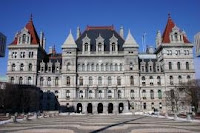 The Preservation League of New York State joined economic development, smart growth and environmental groups in denouncing the Legislature’s plans on tax law amendments that it says will “undermine years of work to revitalize the upstate economy, protect open space and foster green initiatives.”
The Preservation League of New York State joined economic development, smart growth and environmental groups in denouncing the Legislature’s plans on tax law amendments that it says will “undermine years of work to revitalize the upstate economy, protect open space and foster green initiatives.”
The New York State Senate and Assembly are considering tax law amendments that would temporarily defer certain state tax credit incentives for up to six years. Among the targeted credits are the recently expanded (2009) NYS Rehabilitation Tax Credit programs. Just last week, the Senate and Assembly passed legislation designed to bolster these programs by bringing new private investment to redevelopment projects.
“The New York State Legislature is considering tax law changes that will gut this program one week after they passed legislation that allows it to attract significant new national investment to distressed communities throughout New York State,” said Jay DiLorenzo, President of the Preservation League. “Just as redevelopment projects are set to launch in cities throughout the state, this proposed change pulls the rug out from beneath their financing plans.”
According to Robert Simpson, CEO of the CenterState Corporation for Economic Opportunity in Syracuse, “This rehabilitation tax credit has been anticipated by many as one of New York’s most effective economic development programs, but before we can begin to realize its long-sought economic and community redevelopment benefits, the Legislature is about strip the program of the incentives that make it work.”
Deferring incentives of the New York State Rehabilitation Tax Credit program are expected to prevent some projects from securing financing, as partners will no longer be assured of a timely return on investment.
“When the expanded Rehabilitation Tax Credit program was adopted in 2009, a number of modifications were made to reflect New York State’s difficult financial situation,” said Daniel Mackay, Director of Public Policy for the Preservation League. “This program has already been adapted to work in a tough fiscal climate. If further changes are imposed upon the program, it will lose all effectiveness as an economic development tool.”
In 2009, the rehabilitation tax credit programs were limited to distressed census tracts in New York State, commercial rehabilitation project credits were capped at a maximum value of $5 million, and the credits were limited to a five-year pilot program, set to sunset in 2014. Despite those limitations, an economic benefits assessment for the program commissioned by the Preservation League showed a $12:1 return on state investment, noting significant job creation and increased local and state tax revenue returns in addition to community redevelopment benefits.
Twenty-eight other business tax credits were also mentioned in legislative discussions, a number of which address environmental clean-ups, promote alternative fuel and energy development, stimulate affordable housing and green building development, and conserve open space.
The tax credits under threat include the Rehabilitation of Commercial (Historic) Properties Credit (expanded in 2009, 2010 enhancement bill is Governor’s program bill, and has passed Senate and Assembly), and the Historic Homeownership Rehabilitation Credit (expanded in 2009, 2010 enhancement bill is Governor’s program bill, and has passed Senate and Assembly).
The proposal under consideration would defer 50% of allowable credits accrued by a project from 2010 – 2013 until 2013 -2016. Rules for allocation in 2013-2016 will be promulgated by the Commissioner of Tax & Finance, so there is not yet any suggestion as to how the credits will be issued in that three year period.